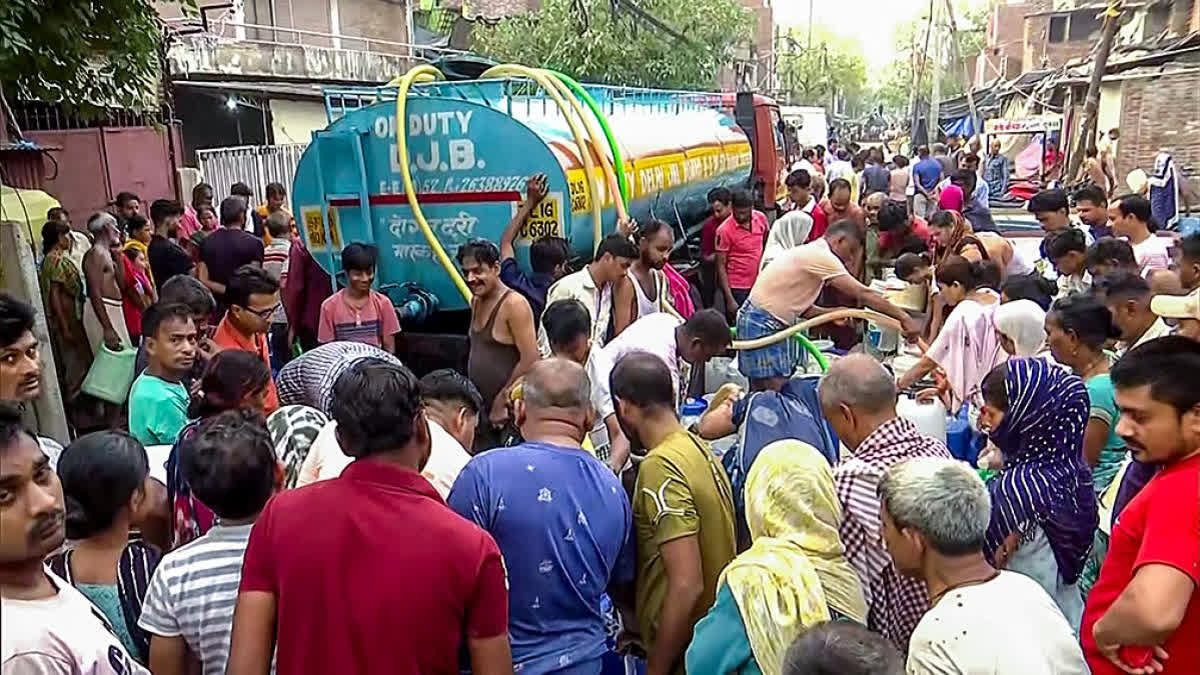The water crisis is fast becoming an existential threat to humans. Some parts of Africa and South Asia are some of the most water-vulnerable parts of the world because of the high rate of water depletion. The world’s water use is expected to increase by over two trillion cubic meters by 2030 – 40% more than the supply. India leads in the projected growth of the world’s urban population between 2018 and 2050. The proportion of the urban population in India increased from 11% in 1901 to about 37.7% in 2017, adding further strain on the resource base.
At the macro level, experts have identified the rising population, an expanding middle class, exploding urban migration and climate change as the main drivers of water shortage. But at the micro-level, it is obvious how water pollution, theft, leakages and neglect exacerbate the problem.
As a fallout of erratic and extreme weather, the situation is expected to worsen with the rural population facing lower productivity and income from their agricultural lands. Over the past three decades, India has been grappling with rapid depletion of groundwater storage, driven by the erratic climate (an overall decline in rainfall) and over-extraction.
Since the Green Revolution in the 1960s, groundwater has been a major source in irrigating water-hungry crops such as rice to feed the country’s growing population. However, the bounty was conditional on the overuse of fertilisers and overexploitation of groundwater. For this reason alone, the aquifer level in the Gangetic plains had lowered by 4 cm per year.
India extracts 75 billion cubic meters of groundwater annually. This is approximately a third of the total groundwater mined globally. The over-exploitation of groundwater in the Indo-Gangetic plains is threatening the hydrological balance. The worst-affected regions include parts of Punjab in Pakistan and Haryana, Uttar Pradesh, Bihar and Bengal in India.
It is estimated that groundwater utilisation in India has increased from 10-20 km3 to 240-260 km3 in the last 50 years. In a performance audit in 2015-16, 14 of 24 states scored below 50% on water management. These "low performers" are concentrated across the populous agricultural belts of north and east India, and the northeastern and Himalayan states.
In a recent paper published in the journal "Earth's Future", a group of researchers, led by Vimal Misra have addressed the groundwater conditions in North India. By relying on direct ground measurements and satellite observations and deriving a hydrological model that incorporates the role of irrigation and groundwater pumping, they conclude that north India is witnessing an accelerating groundwater depletion due to "summer monsoon drying and winter warming", from 1951 to 2021.
The estimates by NITI Aayog show that 40% of Indians will have “no access to drinking water” by 2030. The government body has also warned that several major cities run the risk of dry aquifers. Consequences of this can be far-reaching as water shortages can hit food supplies, causing prices to soar and fuelling social unrest, according to researchers.
Groundwater contamination
Along with the dwindling sources of water, the contamination of groundwater has also reached alarming levels in several parts of the country. India ranks 120th among 122 countries on a global water quality index.
Parts of Odisha, Bengal, Rajasthan and Gujarat are affected by geogenic as well as anthropogenic contamination. Fluoride toxicity is reported in many districts of Odisha and Rajasthan which resulted in acute health problems, especially among children.
Ground-based studies also indicate increased salinity and nitrate contaminants in the lower reaches of the rivers. The arsenic toxicity of the Bengal basin is another serious problem. Large-scale pumping transfers the arsenic present in the deeper levels to shallow depths and the pumped water consequently contaminates the soil and accumulates in paddy grains.
The contaminants, except uranium, can be removed from the water. However, the country lacks technological remedies for treating both wastewater and potable water. Most of the megacities of India lack treatment plants for wastewater treatment. Kolkata, for example, generates about 750 million litres of wastewater and sewage daily. The city does not have a single sewage treatment plant with the sewage finally ending up in the East Kolkata Wetlands.
Politicians are now touting the concept of interlinking all major rivers (inter-basin water transfers) as a geoengineering solution to the continued water depletion. To know river diversions is a blunder, all one has to do is to understand how a great lake called the Aral Sea dried up after the Soviet irrigation projects diverted the rivers that fed it. The transformation of this lake into a piece of desert destroyed the entire ecosystem associated with the Aral Sea Lake. By diverting river water, we are starving deltaic regions of freshwater that would help balance saltwater coming from the sea.
The Indus Delta offers a crucial lesson here. Alice Albinia, in her 2008 book Empires of the Indus narrates how a delta system at the mouth of the Indus River – which was once “the richest in all Pakistan” – became impoverished when the British started their barrage construction, which Pakistan continued post-1947. Such examples are aplenty in India as well. The state of downstream parts of the Narmada River since the completion of the Sardar Sarovar Dam is a modern example in the making.
Need for interventions
India's water crisis is spiralling out of control, primarily due to poor water and environmental management, inadequate or unclear laws and corruption. A national water policy should involve a holistic approach to watershed management with a participatory role for local citizens in monitoring the hydrological cycle with the help of hydrologists, engineers and biologists.
The policy should include effective aquifer management and facilitating regulation of water usage. Farmers should be taken into confidence in this exercise to help devise plans for efficient usage of water for irrigation. The government has little control over the wastewater and should devise imaginative re-use programmes.
Israel, a desert country, is a success story in water resource management. Its biggest success in this regard lies in the modernisation of irrigation techniques. In Let There Be Water, Seth Siegel notes that their drip irrigation programmes save about 25-75% of pumped water. This also compels the farmers to use less water, fertilisers and pesticides. The health of the aquifer is thus maintained at an optimum level. Along with such interventions, we need to incorporate elements of site-specific indigenous practices in watershed management strategies.
Besides the farming sectors, another key area of water crisis lies in our urban centres, in terms of water shortage and flooding. They include upgrading drainage systems and monitoring mechanisms to prevent urban flooding. that manage water flows. Our sewer systems are designed only for "normal" rainfall.
In the event of more infrequent heavy rainfall events, it quickly reaches its capacity limits and runs full. We need to have wider and deeper drainage systems free of solid waste and garbage to allow the free flow of water. A major problem with concrete or pipe-based solutions that funnel water away from flooded areas is that they are not only expensive as they require constant maintenance and lack flexibility.
An emerging idea which is being tried in some cities of the world is the model of the 'sponge city', as a nature-based solution to address the water crisis. The methods include the use of permeable asphalt to increase water percolation, the construction of new canals and ponds and the restoration of wetlands to stabilise the groundwater table.
Many elements of sponge city models are implemented in Tianjin and Wuhan cities in China, Berlin in Germany, some parts of the city-state of Singapore and Melbourne in Australia. As reported in a recent article dated August 13, 2024, published by CNN, in Wuhan, where more than 380 sponge projects — including urban gardens, parks and green spaces — absorb and divert rainwater to artificial lakes, local air quality and biodiversity were found to have improved. It will also help in reducing urban temperature and addressing water shortages.
The recycling of wastewater is another area that needs greater attention in India. The smart city concept followed in India should be able to incorporate the advanced elements of waste-water purification technology followed in eco-cities that are designed for resilience against flooding as well as droughts. Waste can be contaminated with different types of undissolved and dissolved materials.
The undissolved materials are filtered out, and the dissolved materials are removed using biological or chemical methods. The city of Berlin has an excellent infrastructure for wastewater treatment and Indian cities can follow such examples to revamp their wastewater treatment plants that include newer techniques like flocculation-filtration and ozonisation methods. If such efforts are not put to work efficiently and promptly, our water future will remain bleak.
(Disclaimer: The opinions expressed in this article are those of the writer. The facts and opinions expressed here do not reflect the views of ETV Bharat)



